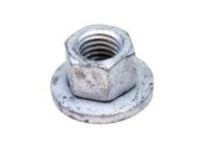Ensure the battery is fully charged and all cable connections at the battery, starter solenoid terminals, and remote terminals are clean and secure. If the starter motor does not function when the switch is operated, verify that the shift lever is in Neutral or Park for automatic transaxles, and check the PARK/NEUTRAL switch. For manual transaxles, inspect the clutch start switch. If the starter motor spins but the engine does not crank, the overrunning clutch in the starter motor may be slipping, necessitating replacement, and the ring gear on the driveplate should be inspected for wear. If the starter motor does not operate but the solenoid clicks, the issue may be with the battery, main solenoid contacts, starter motor, or possibly a seized engine. If the solenoid plunger is not audible when the switch is actuated, the battery may be faulty, the fusible link could be burned, the starter relay might be defective, or the solenoid itself may be at fault. To test the solenoid, connect a remote starter switch between the positive remote battery terminal and the ignition switch wire terminal on the solenoid; if the starter motor operates, the solenoid is functioning correctly. Locate the starter relay in the Power Distribution Center, remove it, and perform tests similar to those for the Automatic Shutdown Relay and fuel pump relay, replacing it if it fails to function. If the starter motor still does not operate, remove the starter/solenoid assembly for replacement as a complete unit. If the starter motor cranks the engine slowly, ensure the battery is charged and all electrical connections are tight; a partially seized engine or incorrect oil viscosity can also cause slow cranking. If the engine starts, run it until normal operating temperature is reached, then turn it off and remove the fuel pump relay to prevent restarting. Connect a voltmeter to the positive and negative remote battery terminals, crank the engine, and take the reading as soon as it stabilizes, ensuring not to crank for more than 15 seconds at a time. A reading of 9 volts or more with normal cranking speed is acceptable; if the reading is 9 volts or more but cranking speed is slow, the motor, solenoid contacts, or circuit connections may be faulty, while a reading below 9 volts with slow cranking likely indicates a bad starter motor.
Posted by MoparPartsGiant Specialist 



